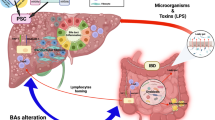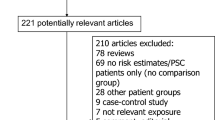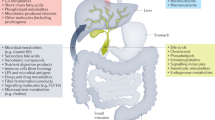Abstract
Secondary sclerosing cholangitis (SSC) is a chronic cholestatic biliary disease, characterized by inflammation, obliterative fibrosis of the bile ducts, stricture formation and progressive destruction of the biliary tree that leads to biliary cirrhosis. SSC is thought to develop as a consequence of known injuries or secondary to pathological processes of the biliary tree. The most frequently described causes of SSC are longstanding biliary obstruction, surgical trauma to the bile duct and ischemic injury to the biliary tree in liver allografts. SSC may also follow intra-arterial chemotherapy. Sclerosing cholangitis in critically ill patients is a largely unrecognized new form of SSC, and is associated with rapid progression to liver cirrhosis. The mechanisms leading to cholangiopathy in critically ill patients are widely unknown; however, the available clinical data indicate that ischemic injury to the intrahepatic biliary tree may be one of the earliest events in the development of this severe form of sclerosing cholangitis. Therapeutic options for most forms of SSC are limited, and patients with SSC who do not undergo transplantation have significantly reduced survival compared with patients with primary sclerosing cholangitis. Sclerosing cholangitis in critically ill patients, in particular, is associated with rapid disease progression and poor outcome.
Key Points
-
Secondary sclerosing cholangitis (SSC) may be caused by various insults to the biliary tree; main causes are chronic biliary obstruction, infectious or toxic cholangitis, immunological causes and ischemic cholangiopathies
-
SSC is a progressive disease characterized by fibrosis and destruction of the biliary tree, which leads to biliary cirrhosis; in most cases, the benefits of therapeutic interventions are limited
-
Sclerosing cholangitis in critically ill patients (SC–CIP) is a new entity of sclerosing cholangiopathy and is associated with a particularly rapid progression of the disease
-
The hallmark of SC–CIP is the early formation of biliary casts; the etiology of SC–CIP may involve early ischemic bile duct injury; however other factors are probably also involved
-
The clinical signs during the initial phase of SC–CIP are not specific; a diagnosis of SC-CIP is often overlooked and, therefore, the frequency of SC–CIP is probably underestimated
-
Aside from transplantation, there are no effective treatment options for SC–CIP; the median survival of patients with SC–CIP who do not undergo liver transplantation is only about 13 months
This is a preview of subscription content, access via your institution
Access options
Subscribe to this journal
Receive 12 print issues and online access
$209.00 per year
only $17.42 per issue
Buy this article
- Purchase on Springer Link
- Instant access to full article PDF
Prices may be subject to local taxes which are calculated during checkout









Similar content being viewed by others
References
Gelbmann, C. M. et al. Ischemic-like cholangiopathy with secondary sclerosing cholangitis in critically ill patients. Am. J. Gastroenterol. 102, 1221–1229 (2007).
Deltenre, P. & Valla, D. C. Ischemic cholangiopathy. J. Hepatol 44, 806–817 (2006).
Sakrak, O., Akpinar, M., Bedirli, A., Akyurek, N. & Aritas, Y. Short and long-term effects of bacterial translocation due to obstructive jaundice on liver damage. Hepatogastroenterology 50, 1542–1546 (2003).
Sherlock, S. Pathogenesis of sclerosing cholangitis: the role of nonimmune factors. Semin. Liver Dis. 11, 5–10 (1991).
Weber, C. et al. Magnetic resonance cholangiopancreatography in the diagnosis of primary sclerosing cholangitis. Endoscopy 40, 739–745 (2008).
Strazzabosco, M., Spirlí, C. & Okolicsanyi, L. Pathophysiology of the intrahepatic biliary epithelium. J. Gastroenterol. Hepatol. 15, 244–253 (2000).
Gossard, A. A., Angulo, P. & Lindor, K. D. Secondary sclerosing cholangitis: a comparison to primary sclerosing cholangitis. Am. J. Gastroenterol. 100, 1330–1333 (2005).
Portmann, B. C. & Nakanuma, Y. Diseases of the bile ducts. In Pathology of the Liver eds Burt, A. D. et al. 517–582 (Churchill Livingstone, Elsevier, New York, 2007).
Sheikh, R. A., Prindiville, T. P., Yenamandra, S., Munn, R. J. & Ruebner, B. H. Microsporidial AIDS cholangiopathy due to Encephalitozoon intestinalis: case report and review. Am. J. Gastroenterol. 95, 2364–2371 (2000).
Yusuf, T. E. & Baron, T. H. AIDS Cholangiopathy. Curr. Treat. Options Gastroenterol. 7, 111–117 (2004).
Chen, X. M., Gores, G. J., Paya, C. V. & LaRusso, N. F. Cryptosporidium parvum induces apoptosis in biliary epithelia by a Fas/Fas ligand-dependent mechanism. Am. J. Physiol. 277, G599–G608 (1999).
Abdo, A., Klassen, J., Urbanski, S., Raber, E. & Swain, M. G. Reversible sclerosing cholangitis secondary to cryptosporidiosis in a renal transplant patient. J. Hepatol. 38, 688–691 (2003).
Campos, M. et al. Sclerosing cholangitis associated to cryptosporidiosis in liver-transplanted children. Eur. J. Pediatr. 159, 113–115 (2000).
Bouche, H. et al. AIDS-related cholangitis: diagnostic features and course in 15 patients. J. Hepatol. 17, 34–39 (1993).
Sahin, M., Eryilmaz, R. & Bulbuloglu, E. The effect of scolicidal agents on liver and biliary tree (experimental study). J. Invest. Surg. 17, 323–326 (2004).
Stamm, B. et al. Satellite cysts and biliary fistulas in hydatid liver disease. A retrospective study of 17 liver resections. Hum. Pathol. 39, 231–235 (2008).
Stamm, B., Fejgl, M. & Hueber, C. High serum IgG4 concentrations in patients with sclerosing pancreatitis. N. Engl. J. Med. 344, 732–738 (2001).
Zen, Y. et al. IgG4-related sclerosing cholangitis with and without hepatic inflammatory pseudotumor, and sclerosing pancreatitis-associated sclerosing cholangitis: do they belong to a spectrum of sclerosing pancreatitis? Am. J. Surg. Pathol. 28, 1193–1203 (2004).
Franceschini, B., Ceva-Grimaldi, G., Russo, C., Dioguardi, N. & Grizzi, F. The complex functions of mast cells in chronic human liver diseases. Dig. Dis. Sci. 51, 2248–2256 (2006).
Garbuzenko, E. et al. Human mast cells stimulate fibroblast proliferation, collagen synthesis and lattice contraction: a direct role for mast cells in skin fibrosis. Clin. Exp. Allergy 32, 237–246 (2002).
Gruber, B. L. Mast cells in the pathogenesis of fibrosis. Curr. Rheumatol. Rep. 5, 147–153 (2003).
Marbello, L. et al. Aggressive systemic mastocytosis mimicking sclerosing cholangitis. Haematologica 89, ECR35 (2004).
Baron, T. H., Koehler, R. E., Rodgers, W. H., Fallon, M. B. & Ferguson, S. M. Mast cell cholangiopathy: another cause of sclerosing cholangitis. Gastroenterology 109, 1677–1681 (1995).
Pometta, R., Callea, F., Mangano, M., Zuccoli, E. & Conte, D. Recurrent cholestasis and hypereosinophilia in a young female. Dig. Liver Dis. 32, 630–633 (2000).
Tenner, S. et al. Eosinophilic cholangiopathy. Gastrointest. Endosc. 45, 307–309 (1997).
Abdalian, R. & Heathcote, E. J. Sclerosing cholangitis: a focus on secondary causes. Hepatology 44, 1063–1074 (2006).
Li, M. K. & Crawford, J. M. The pathology of cholestasis. Semin. Liver Dis. 24, 21–42 (2004).
Kobayashi, S., Nakanuma, Y. & Matsui, O. Intrahepatic peribiliary vascular plexus in various hepatobiliary diseases: a histological survey. Hum. Pathol. 25, 940–946 (1994).
Batts, K. P. Ischemic cholangitis. Mayo Clin. Proc. 73, 380–385 (1998).
Shah, J. N. et al. Biliary casts after orthotopic liver transplantation: clinical factors, treatment, biochemical analysis. Am. J. Gastroenterol. 98, 1861–1867 (2003).
Fisher, A. & Miller, C. H. Ischemic-type biliary strictures in liver allografts: the Achilles heel revisited? Hepatology 21, 589–591 (1995).
Sankary, H. N. et al. A simple modification in operative technique can reduce the incidence of nonanastomotic biliary strictures after orthotopic liver transplantation. Hepatology 21, 63–69 (1995).
Gugenheim, J. et al. Rejection of ABO incompatible liver allografts in man. Transplant. Proc. 21, 2223–2224 (1989).
Busquets, J. et al. Postreperfusion biopsies are useful in predicting complications after liver transplantation. Liver Transpl. 7, 432–435 (2001).
Ludwig, J., Wiesner, R. H., Batts, K. P., Perkins, J. D. & Krom, R. A. The acute vanishing bile duct syndrome (acute irreversible rejection) after orthotopic liver transplantation. Hepatology 7, 476–483 (1987).
Ludwig, J., Batts, K. P. & MacCarty, R. L. Ischemic cholangitis in hepatic allografts. Mayo Clin. Proc. 67, 519–526 (1992).
Sanchez-Urdazpal, L. et al. Increased bile duct complications in liver transplantation across the ABO barrier. Ann. Surg. 218, 152–158 (1993).
Scotte, M. et al. The influence of cold ischemia time on biliary complications following liver transplantation. J. Hepatol. 21, 340–346 (1994).
Guichelaar, M. M. et al. Risk factors for and clinical course of nonanastomotic biliary strictures after liver transplantation. Am. J. Transplant. 3, 885–890 (2003).
Sebagh, M. et al. Sclerosing cholangitis following human orthotopic liver transplantation. Am. J. Surg. Pathol. 19, 81–90 (1995).
Hohn, D. et al. Biliary sclerosis in patients receiving hepatic arterial infusions of floxuridine. J. Clin. Oncol. 3, 98–102 (1985).
Makuuchi, M. et al. Bile duct necrosis: complication of transcatheter hepatic arterial embolization. Radiology 156, 331–334 (1985).
Scheppach, W. et al. Sclerosing cholangitis and liver cirrhosis after extrabiliary infections: report on three cases. Crit. Care Med. 29, 438–441 (2001).
Engler, S. et al. Progressive sclerosing cholangitis after septic shock: a new variant of vanishing bile duct disorders. Gut 52, 688–693 (2003).
Benninger, J. et al. Sclerosing cholangitis following severe trauma: description of a remarkable disease entity with emphasis on possible pathophysiologic mechanisms. World J. Gastroenterol. 11, 4199–4205 (2005).
Jaeger, C. et al. Secondary sclerosing cholangitis after long-term treatment in an intensive care unit: clinical presentation, endoscopic findings, treatment, and follow-up. Endoscopy 38, 730–734 (2006).
Kulaksiz, H., Heuberger, D., Engler, S. & Stiehl, A. Poor outcome in progressive sclerosing cholangitis after septic shock. Endoscopy 40, 214–218 (2008).
Esposito, I., Kubisova, A., Stiehl, A., Kulaksiz, H. & Schirmacher, P. Secondary sclerosing cholangitis after intensive care unit treatment: clues to the histopathological differential diagnosis. Virchows Arch. 453, 339–345 (2008).
Xia, X. et al. Cholangiocyte injury and ductopenic syndromes. Semin. Liver Dis. 27, 401–412 (2007).
Lazaridis, K. N., Strazzabosco, M. & Larusso, N. F. The cholangiopathies: disorders of biliary epithelia. Gastroenterology 127, 1565–1577 (2004).
Strazzabosco, M., Fabris, L. & Spirli, C. Pathophysiology of cholangiopathies. J. Clin. Gastroenterol. 39, S90–S102 (2005).
Wagner, M., Zollner, G. & Trauner, M. Ischemia and cholestasis: more than (just) the bile ducts! Transplantation 85, 1083–1085 (2008).
Waldram, R., Williams, R. & Calne, R. Y. Bile composition and bile cast formation after transplantation of the liver in man. Transplantation 19, 382–387 (1975).
Pfau, P. R. et al. Endoscopic management of postoperative biliary complications in orthotopic liver transplantation. Gastrointest. Endosc. 52, 55–63 (2000).
Tung, B. Y. & Kimmey, M. B. Biliary complications of orthotopic liver transplantation. Dig. Dis. 17, 133–144 (1999).
Chen, C. L. et al. Biliary sludge-cast formation following liver transplantation. Hepatogastroenterology 35, 22–24 (1988).
Starzl, T. E., Putnam, C. W., Hansbrough, J. F., Porter, K. A. & Reid, H. A. Biliary complications after liver transplantation: with special reference to the biliary cast syndrome and techniques of secondary duct repair. Surgery 81, 212–221 (1977).
Cameron, A. M. & Busuttil, R. W. Ischemic cholangiopathy after liver transplantation. Hepatobiliary Pancreat. Dis. Int. 4, 495–501 (2005).
Parry, S. D. & Muiesan, P. Cholangiopathy and the biliary cast syndrome. Eur. J. Gastroenterol. Hepatol. 15, 341–343 (2003).
McMaster, P. et al. The development of biliary “sludge” following liver transplantation. Transplant. Proc. 11, 262–266 (1979).
Putensen, C., Wrigge, H. & Hering, R. The effects of mechanical ventilation on the gut and abdomen. Curr. Opin. Crit. Care 12, 160–165 (2006).
Woolsey, C. A. & Coopersmith, C. M. Vasoactive drugs and the gut: is there anything new? Curr. Opin. Crit. Care 12, 155–159 (2006).
Krejci, V., Hiltebrand, L. B. & Sigurdsson, G. H. Effects of epinephrine, norepinephrine, and phenylephrine on microcirculatory blood flow in the gastrointestinal tract in sepsis. Crit. Care Med. 34, 1456–1463 (2006).
Trauner, M., Fickert, P. & Wagner, M. MDR3 (ABCB4) defects: a paradigm for the genetics of adult cholestatic syndromes. Semin. Liver Dis. 27, 77–98 (2007).
Fickert, P. et al. Ursodeoxycholic acid aggravates bile infarcts in bile duct-ligated and Mdr2 knockout mice via disruption of cholangioles. Gastroenterology 123, 1238–1251 (2002).
Fickert, P. et al. Regurgitation of bile acids from leaky bile ducts causes sclerosing cholangitis in Mdr2 (Abcb4) knockout mice. Gastroenterology 127, 261–274 (2004).
Acknowledgements
Charles P. Vega, University of California, Irvine, CA, is the author of and is solely responsible for the content of the learning objectives, questions and answers of the Medscape-accredited continuing medical education activity associated with this article.
Author information
Authors and Affiliations
Corresponding author
Ethics declarations
Competing interests
The authors declare no competing financial interests.
Rights and permissions
About this article
Cite this article
Ruemmele, P., Hofstaedter, F. & Gelbmann, C. Secondary sclerosing cholangitis. Nat Rev Gastroenterol Hepatol 6, 287–295 (2009). https://doi.org/10.1038/nrgastro.2009.46
Issue Date:
DOI: https://doi.org/10.1038/nrgastro.2009.46
This article is cited by
-
Diagnosis of functional strictures in patients with primary sclerosing cholangitis using hepatobiliary contrast-enhanced MRI: a proof-of-concept study
European Radiology (2023)
-
Secondary sclerosing cholangitis: mimics of primary sclerosing cholangitis
Abdominal Radiology (2022)
-
Persistierende Transaminasenerhöhung und Hepatopathie nach schwerer Grunderkrankung im frühen Kindesalter
Monatsschrift Kinderheilkunde (2022)
-
Secondary sclerosing cholangitis after COVID-19 pneumonia: a report of two cases and review of the literature
Clinical Journal of Gastroenterology (2022)
-
Radiologic findings of biliary complications post liver transplantation
Abdominal Radiology (2022)



